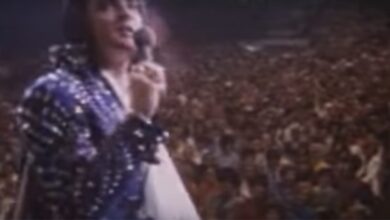When He Begins The Third Verse, It Becomes The Most Exquisite Sound Ever Crafted
Elvis Presley’s live rendition of “Never Been To Spain” during his 1972 performances in Las Vegas stands as a pinnacle of his illustrious career. Written by Hoyt Axton and originally popularized by Three Dog Night in 1971, the song took on new life in the hands of Elvis, becoming one of his most beloved covers. Known for his seamless fusion of rock, blues, and soul, Elvis infused “Never Been To Spain” with his trademark charisma and vocal prowess.
In this live performance, Elvis’s mastery of the stage is evident from the outset. Backed by a dynamic rhythm section and punctuated by powerful horns, the song’s arrangement complements Elvis’s commanding vocals. His delivery is both soulful and impassioned, drawing listeners into the narrative of a man yearning for exploration despite never having ventured far from home. Each lyric is imbued with Elvis’s personal touch, his emotive interpretation adding layers of depth to the song’s already evocative lyrics. The song’s themes of longing and adventure resonate powerfully with audiences, evoking a universal wish to see the world while reflecting on the comforts of home.
Throughout the performance, Elvis effortlessly captivates the audience with his magnetic presence and infectious energy. His stage persona, a mix of suave charm and raw emotion, underscores his ability to connect intimately with his audience. In moments when he engages directly with fans, inviting their responses, it creates an electric atmosphere that enhances the experience. Whether belting out the song’s anthemic chorus or delivering a tender verse, Elvis’s versatility shines through, showcasing his ability to navigate between powerful, soul-stirring moments and more introspective passages that invite reflection.
The Las Vegas setting provides a perfect backdrop for Elvis’s larger-than-life performance. Known for his residency shows in the city, Elvis’s concerts there became legendary for their spectacle and sheer entertainment value. The glitz and glamour of Las Vegas, along with the uniquely intimate environment of the large auditorium, set the stage for memorable performances that blended musical artistry with theatrical flair. In “Never Been To Spain,” Elvis not only entertains but also communicates a sense of wanderlust and longing that resonates deeply with his audience, enhancing the emotional depth of the song.
Elvis Presley, born in Tupelo, Mississippi, on January 8, 1935, rose to prominence in the 1950s as a pioneer of rock and roll. His impact on popular music and culture is immeasurable, with a career that spanned genres and generations. From his early days at Sun Records, where he recorded seminal hits like “That’s All Right” and “Hound Dog,” to his iconic performances in Las Vegas and beyond, Elvis remains an enduring symbol of musical innovation and charisma. His legacy, shaped by raw talent and a cultural zeitgeist that embraced rebellion, undoubtedly changed the music industry forever, paving the way for countless artists who followed.
His ability to reinterpret songs and make them uniquely his own, as demonstrated in “Never Been To Spain,” underscores his artistic depth and influence. This performance not only showcases Elvis’s vocal talents but also highlights his skillful artistry in making a song relatable to his personal journey and experiences. Beyond the music, Elvis’s legacy encompasses his cultural impact, from his iconic fashion choices—such as the jumpsuits that adorned him during his later live performances—to his on-screen charisma in films like “Jailhouse Rock” and “Blue Hawaii.” His life and career continue to fascinate and inspire, making him a timeless icon whose music and influence resonate to this day.
Elvis’s evolution as an artist throughout the years is noteworthy, reflecting broader shifts in music and culture. His forays into gospel, country, and rhythm and blues not only enriched his repertoire but also showcased his profound respect for various musical influences. Each genre he explored contributed to an ever-expanding artistry that allowed him to remain relevant as musical tastes evolved through the 1960s and into the 1970s.
In addition to his musical contributions, Elvis’s life story is also a narrative marked by both triumph and tragedy. The pressures of fame, personal struggles, and the impact of his lifestyle choices are essential parts of his story. His later years in Las Vegas, though filled with electrifying performances, were also shadowed by personal challenges that affected his health and well-being. This complexity adds a depth to his persona; it serves as a reminder that behind the glittering façade was a man grappling with the very human experiences of fame, love, and loss.
In conclusion, Elvis Presley’s live performance of “Never Been To Spain” in 1972 exemplifies his unparalleled ability to captivate an audience and breathe new life into a song. It stands as a testament to his artistic vision and enduring appeal, showcasing why he remains a cultural icon whose influence transcends generations. His dedication to his craft and his ability to convey emotion through performance ensure that Elvis’s music continues to inspire new fans, keeping the spirit of rock and roll alive for years to come. As we revisit his work, particularly in performances like this, we are reminded of his profound impact on music history and the indelible mark he left on the world.





